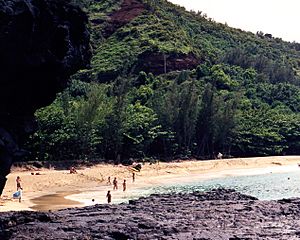Lumahaʻi River facts for kids
Quick facts for kids Lumaha'i River |
|
|---|---|
| Country | Hawaii, U.S. |
| Physical characteristics | |
| Main source | Central mountains of Kauai 430 metres (1,410 ft) |
| River mouth | Lumaha'i Beach |
| Length | 9.6 miles (15.4 km) |
| Basin features | |
| Basin size | 23 square miles (60 km2) |
The Lumaha'i River is a beautiful river found on the northern side of Kauai, Hawaii, in the United States. It starts high up in the central mountains within a narrow valley. The river then flows into the Pacific Ocean on the island's northwestern coast. This happens just east of Wainiha, right at the western edge of Lumaha'i Beach.
The river's waters are very clean because they haven't been changed by buildings or other human activities. Many native animals live here, including o'opu (a type of fish) and hihiwai (a kind of shellfish). You can also spot the Hawaiian coot, a special bird. During heavy rains in winter and spring, the river can sometimes flood its banks. A bridge called the Lumaha'i River Bridge crosses over this waterway.
Contents
Exploring the Lumaha'i River's Geography
The Lumaha'i River begins in the middle of Kauai's mountains. It starts at a height of about 430 meters (1,410 feet) above sea level. The river collects water from an area of about 23 square miles (60 square kilometers).
At first, the river flows through a narrow valley with tall, steep cliffs. As it moves further, the valley opens up into a wider area. The river's banks here are still quite steep. Finally, the Lumaha'i River empties into the Pacific Ocean. This happens on the northwestern coast of Kauai, just east of Wainiha. It meets the ocean at the western edge of Lumaha'i Beach.
Lumaha'i Beach and Its Features
The beach at the river's mouth is known as Lumaha'i Beach. It's located about 1.4 miles (2.3 kilometers) northwest of Hanalei. This beach is about 4,000 feet (1,200 meters) long. Near where the river meets the ocean, there are rocky areas. These rocks can create strong and dangerous "rip currents" in the water. A rip current is a powerful, narrow channel of water moving quickly away from the shore. This beach is also famous for being a filming location for a song in the 1958 movie South Pacific.
The rocks at the river's mouth are a reddish color. Hawaiians call them Ka-‘alele, which means "messenger." Even when the ocean tides are low, the waves on this beach can be very strong. There are no coral reefs in the water here to calm the waves. On the west side of the river's mouth, there's a black lava formation. It's named Ke-alelo-O-Pilikua, which means "tongue of Pilikua."
Unique Rock Formations in the Valley
In the hills of the Lumaha'i River valley, there's a large rock formation. Hawaiians know it as Ma’ina-kehau. This huge boulder looks like a man with a "grey body and white head."
Midway along the river, there's a natural waterfall. Near it, you can find a flat, carved rock. Legend says the Menehune, a mythical small people of Hawaii, brought this rock from Wainiha. This special rock is called Pa-na’nana’a, meaning "protruding dish." One half of this rock is black, and the other half is grey.
Wildlife in the Lumaha'i River Valley

The Lumaha'i River's clean waters are home to many interesting creatures. You can find o'opu, which are native Hawaiian gobies (a type of fish). There are also hihiwai, a kind of freshwater shellfish. The Hawaiian coot, a water bird, also lives here. It's said that another freshwater shellfish species called wi can be seen on the grey part of the Pa-na’nana’a rock during the day. At night, they appear on the black side of the rock.
The lowland wet forest in the Lumaha'i valley is very special. It has more than 12 types of rare plants that grow nowhere else. Many migratory seabirds also make their homes here. These include the Newell's shearwater and the Hawaiian petrel.
Near the mouth of the river, there are three important types of trees. These are the hibiscus of Maihi, the breadfruit of Weli, and the pandanus of Mapuana.


